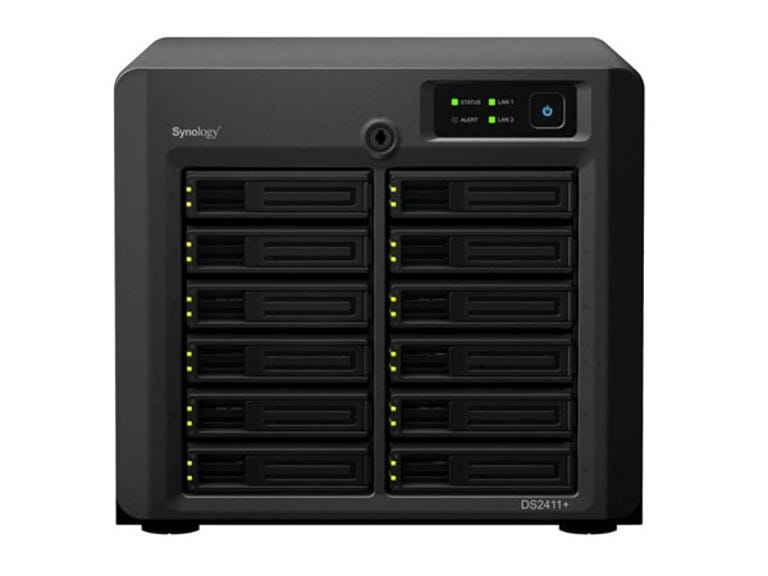 Why You Can Trust CNET
Why You Can Trust CNET Synology DS2411+ review: Synology DS2411+
While the DS2411+ could do with a little aesthetic tweaking hardware-wise, Synology maintains its reputation in delivering an excellent product, particularly on the software side.
The first thing that strikes you about the DS2411+ is that it looks partly like a subwoofer, and despite its ability to store 12 3.5-inch hard drives, is low key enough that it could hide in plain sight in a lounge room. Despite this, it's not as attractive as QNAP's design, and the drive caddies could do with a bit of work in terms of uniformly slotting into place.
The Good
The Bad
The Bottom Line
Flip it around to the back, and you've got four USB 2.0 ports, a VGA port and serial port for troubleshooting, and dual-gigabit Ethernet ports. Synology could afford to be more generous here, offering USB 3.0 or eSATA. Competitors like QNAP also offer a customisable "backup" button, linked to a USB port on the front that can ease quick transfer.
One thing could stop the DS2411+'s entry into the lounge room: despite having twin 120mm fans that are quiet enough, the power supply makes a strange, rattling electrical noise, something that will annoy the sharp of hearing. Of course, in the datacentre, this will annoy no one at all.
Open the NAS up, and the first thing you'll notice is the huge amount of empty space behind the drives. It's doubtful anything else could be put here considering the layout and requirements of the device, and it no doubt assists with airflow — it's just an odd sight after seeing so many extremely packed NAS.
Missing is any sort of display — the DS2411+ relies on LEDs for status, LAN activity and errors, meaning you'll have to use Synology's software for set up and finding the internet protocol (IP). You'll also want to have all disks you use be blasted free of partitions; we found that Synology's software freaked out when we used disks that had come from another NAS.
Synology's initial set up differs from competitors in that you have to download the latest firmware from its website. It's a great way to ensure that things are kept up to date. We took the punt and went with Synology's 4.0 beta, rather than the 3.2 stable, to see what Synology had coming around the corner.
One thing is immediately apparent: Synology makes beautiful interfaces for its firmware. Should the company ever move into routers, they could have a captive market. DSM, Synology's operating system, is instantly understandable and approachable to anyone who's used a Windows or OS X system, despite having a huge amount of features. There's even a taskbar along the top that keeps track of which windows are open.

Synology's UI is vastly ahead of its competitors.
(Screenshot by Craig Simms/CBSi)
It's also incredibly helpful to the user; for example, if you go into folder shares and haven't created one, you're prompted to do so, and the correct dialog is opened so you can do it. Magical time-saving stuff. The at-a-glance system health reports on the right are also incredibly useful for sysadmins.
The usual mess of things are supported here: CIFS, AFP, NFP, WebDAV, SNMP, iSCSI protocols; FTP, SSH, Telnet, HTTP and mail servers; user/group/domain administration; DDNS support and more.
There are a few things that set Synology apart. For one, it can message system events to Skype or Windows Live Messenger accounts. Considering Google uses Jabber, we'd love to have seen Google Talk support in there as well. Email and SMS notification are also supported, and Synology offers an incredibly granular, customisable set of events that will trigger certain notifications. For example, if the NAS finishes a consistency check it might only send you an email, but a CPU fan failure would blast all contacts. A firewall is also handily included, as is the ability to block specific IPs from accessing the NAS.
No doubt to minimise its DSM download size, Synology has excised other features and made them available for download in its Package Center, along with other third-party applications. In a refreshing move away from competitors, these packages are directly browsable and installable within the NAS, rather than the user having to upload a file. There's antivirus software, iTunes and VPN servers, IP cam software, WordPress installs, photo album browsers, download tools and more.
Installing extra packages from within the NAS: fantastic. We do wish there was an offline way to do it though, just in case you want your NAS separated from the online world.
(Screenshot by Craig Simms/CBSi)
For file system, Synology exclusively uses EXT4, while it offers RAID levels up to RAID 6. Interestingly, like Drobo and Netgear, Synology has included a mix-and-match storage pool technology, called SHR. While it's not quite true mix and match — if you plan to add volumes later, you can't add smaller ones than the first volumes you added to the array — it gives a bit of extra flexibility, and can be configured for single- or double-disk redundancy.
Transferring a 6GB file to the NAS over a gigabit network to a five-drive, RAID 5 array netted an average speed of 100MBps, while transferring back to the client achieved an average of 110MBps.
While the DS2411+ could do with a little aesthetic tweaking hardware-wise, Synology maintains its reputation in delivering an excellent product, particularly on the software side.



